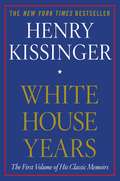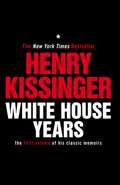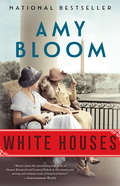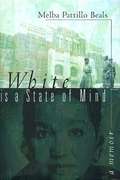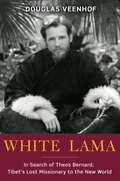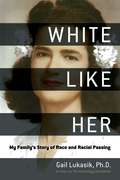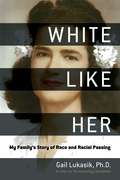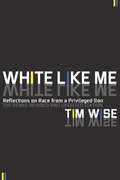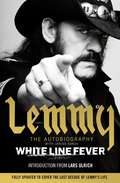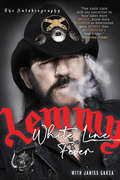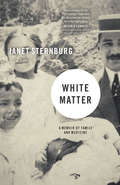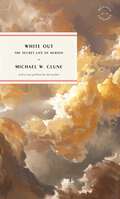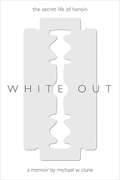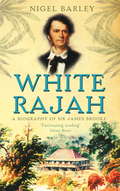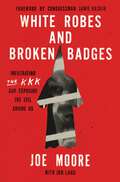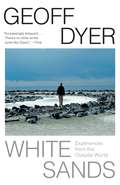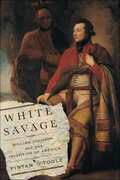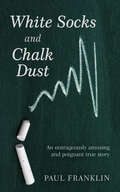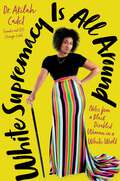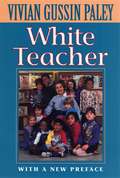- Table View
- List View
White House Years: The First Volume Of His Classic Memoirs
by Henry KissingerOne of the most important books to come out of the Nixon Administration, the New York Times bestselling White House Years covers Henry Kissinger&’s first four years (1969–1973) as Assistant to the President for National Security Affairs.Among the momentous events recounted in this first volume of Kissinger’s timeless memoirs are his secret negotiations with the North Vietnamese in Paris to end the Vietnam War, the Jordan crisis of 1970, the India-Pakistan war of 1971, his back-channel and face-to-face negotiations with Soviet leaders to limit the nuclear arms race, his secret journey to China, and the historic summit meetings in Moscow and Beijing in 1972. He covers major controversies of the period, including events in Laos and Cambodia, his “peace is at hand” press conference and the breakdown of talks with the North Vietnamese that led to the Christmas bombing in 1972. Throughout, Kissinger presents candid portraits of world leaders, including Richard Nixon, Anwar Sadat, Golda Meir, Jordan’s King Hussein, Leonid Brezhnev, Chairman Mao and Chou En-lai, Willy Brandt, Charles de Gaulle, and many others. White House Years is Henry Kissinger’s invaluable and lasting contribution to the history of this crucial time.
White House Years: The First Volume of His Classic Memoirs
by Henry KissingerThis monumental work, covering Kissinger's first four years (1969-1973) as Assistant to the President for National Security Affairs and President Nixon's closest advisor on foreign policy, is one of the most significant books to come out of the Nixon administration. Among the countless moments Kissinger recalls in White House Years are his first meeting with Nixon, his secret trip to China, the first SALT negotiations, the Jordan crisis of 1970, the India-Pakistan war of 1971, and the historic summit meetings in Moscow and Beijing in 1972. He offers insights into the Middle East conflicts, Anwar Sadat's break with the Soviet Union, the election of Salvador Allende in Chile, issues of defense strategy, and relations with Europe and Japan. Other highlights are his relationship with Nixon, brilliant portraits of major foreign leaders, and his views on handling crises and the art of diplomacy. Few men have wielded as much influence on American foreign policy as Henry Kissinger. White House Years, his own record, makes an invaluable and lasting contribution to the history of this crucial time.
White House by the Sea: A Century of the Kennedys at Hyannis Port
by Kate Storey* #1 Must-Read Book of the Summer by Town & Country * Most Anticipated Book of the Summer by Elle * The intimate, multi-generational story of the Kennedy family as seen through their Hyannis Port compound on Cape Cod—the iconic place where they&’ve celebrated, mourned, and forged the closest of bonds—based on more than a hundred in-depth interviews by a Rolling Stone editor whose pieces have appeared in such publications as Town & Country, Esquire, and Vanity Fair.Hyannis Port, Massachusetts, is synonymous with the Kennedy family. It is where, for a hundred years, America&’s most storied political family has come to celebrate, bond, play, and, also, grieve. It is also the setting of so many events we remember: JFK giving his presidential acceptance speech, Jackie speaking with a Life magazine reporter just days after her husband&’s assassination, Senator Edward Kennedy seeking refuge after the Chappaquiddick crash, Maria Shriver and Arnold Schwarzenegger tying the knot—and even Conor Kennedy courting pop star Taylor Swift. Anyone who has lived in, worked at, or visited the Kennedy compound in Hyannis Port has had a front-row view to history. Now, with extraordinary access to the Kennedy family—and featuring more than fifty rarely-seen images—journalist Kate Storey gives us a remarkably intimate and poignant look at the rhythms of an American dynasty. Drawing from more than a hundred conversations with family members, friends, neighbors, household and security staff, Storey delivers a rich and textured account of the Kennedys&’ lives in their summer refuge. From the 1920s, when Rose and Joseph P. Kennedy rented then bought a home known as The Malcolm Cottage, to today, when many Kennedys have purchased their own homes surrounding what&’s now called The Big House, this book delivers many surprising revelations across the decades, including what matriarch Rose considered the family&’s greatest tragedy, the rivalrous relationship between brothers Jack and Joe, details about Jackie&’s life at the compound, and previously unknown glimpses into JFK Jr. and Carolyn Bessette&’s loving and ill-fated relationship. Fascinating, engaging, and illuminating, White House by the Sea provides a sweeping history of an American dynasty that has left an indelible mark on our nation&’s politics and culture.
White Houses: A Novel
by Amy BloomLorena Hickok meets Eleanor Roosevelt in 1932 while reporting on Franklin Roosevelt’s first presidential campaign. Having grown up worse than poor in South Dakota and reinvented herself as the most prominent woman reporter in America, “Hick,” as she’s known to her friends and admirers, is not quite instantly charmed by the idealistic, patrician Eleanor. But then, as her connection with the future first lady deepens into intimacy, what begins as a powerful passion matures into a lasting love, and a life that Hick never expected to have. She moves into the White House, where her status as “first friend” is an open secret, as are FDR’s own lovers. <P><P>After she takes a job in the Roosevelt administration, promoting and protecting both Roosevelts, she comes to know Franklin not only as a great president but as a complicated rival and an irresistible friend, capable of changing lives even after his death. Through it all, even as Hick’s bond with Eleanor is tested by forces both extraordinary and common, and as she grows as a woman and a writer, she never loses sight of the love of her life. From Washington, D.C. to Hyde Park, from a little white house on Long Island to an apartment on Manhattan’s Washington Square, Amy Bloom’s new novel moves elegantly through fascinating places and times, written in compelling prose and with emotional depth, wit, and acuity.
White Is a State of Mind
by Melba Pattillo BealsNamed by the American Library Association as 1995's Nonfiction Book of the Year, Warriors Don't Cry told the story of Melba Pattillo Beals, one of the "Little Rock Nine" who desegregated Central High School and played a significant role in civil rights history. This is the sequel, continuing Beals' story.
White Lama: The Life of Tantric Yogi Theos Bernard, Tibet's Lost Emissary to the New World
by Douglas VeenhofAn amazing, often overlooked story of the man who brought Yoga and Tibetan culture to America. Theos Bernard's colorful, enigmatic, and sometimes contradictory life captures an intersection of East and West that changed our world. After years of forcibly stopping foreigners at the borders, the leaders of Tibet opened the doors to their kingdom in 1937 for Theos Bernard. He was the third American to set foot in Tibet and the first American ever initiated into Tantric practices by the highest lama in Tibet. When Bernard left that sacred land, he was sent home with fifty mule loads of priceless, essential Buddhist scriptures from government and monastery vaults. Bernard brought these writings to America, where he achieved celebrity as a spiritual master. Appearing four times on the cover of the largest-circulation magazine of the day, befriending some of the most famous figures of his era, including Charles Lindbergh, Lowell Thomas, Ganna Walska, and W. Y. Evans-Wentz, and working with legendary editor Maxwell Perkins, the charismatic and controversial "White Lama" introduced a new vision of life and spiritual path to American culture before mysteriously disappearing in the Himalayas in 1947.Biography, travel and adventure, a history of Tibet's opening to the West, and the story of Buddhism and Yoga's arrival in America, White Lama: The Life of Tantric Yogi Theos Bernard, Tibet's Lost Emissary to the West is the first work to tell his groundbreaking story in full and is a narrative that thrills from beginning to end.
White Lies: The Double Life of Walter F. White and America's Darkest Secret
by A. J. BaimeA riveting biography of Walter F. White, a little-known Black civil rights leader who passed for white in order to investigate racist murders, help put the NAACP on the map, and change the racial identity of America forever Walter F. White led two lives: one as a leader of the Harlem Renaissance and the NAACP in the early twentieth century; the other as a white newspaperman who covered lynching crimes in the Deep South at the blazing height of racial violence. Born mixed race and with very fair skin and straight hair, White was able to &“pass&” for white. He leveraged this ambiguity as a reporter, bringing to light the darkest crimes in America and helping to plant the seeds of the civil rights movement. White&’s risky career led him to lead a double life. He was simultaneously a second-class citizen subject to Jim Crow laws at home and a widely respected professional with full access to the white world at work. His life was fraught with internal and external conflict—much like the story of race in America. Starting out as an obscure activist, White ultimately became Black America&’s most prominent leader. A character study of White&’s life and career with all these complexities has never been rendered, until now. By the award-winning, best-selling author of The Accidental President,Dewey Defeats Truman, and The Arsenal of Democracy,White Lies uncovers the life of a civil rights leader unlike any other.
White Like Her: My Family's Story of Race and Racial Passing
by Gail LukasikWhite Like Her: My Family’s Story of Race and Racial Passing is the story of Gail Lukasik’s mother’s “passing,” Gail’s struggle with the shame of her mother’s choice, and her subsequent journey of self-discovery and redemption. <P><P>In the historical context of the Jim Crow South, Gail explores her mother’s decision to pass, how she hid her secret even from her own husband, and the price she paid for choosing whiteness. Haunted by her mother’s fear and shame, Gail embarks on a quest to uncover her mother’s racial lineage, tracing her family back to eighteenth-century colonial Louisiana. In coming to terms with her decision to publicly out her mother, Gail changed how she looks at race and heritage. <P><P>With a foreword written by Kenyatta Berry, host of PBS's Genealogy Roadshow, this unique and fascinating story of coming to terms with oneself breaks down barriers.
White Like Her: My Family's Story of Race and Racial Passing
by Gail Lukasik Kenyatta BerryWhite Like Her: My Family’s Story of Race and Racial Passing is the story of Gail Lukasik’s mother’s “passing,” Gail’s struggle with the shame of her mother’s choice, and her subsequent journey of self-discovery and redemption. In the historical context of the Jim Crow South, Gail explores her mother’s decision to pass, how she hid her secret even from her own husband, and the price she paid for choosing whiteness. Haunted by her mother’s fear and shame, Gail embarks on a quest to uncover her mother’s racial lineage, tracing her family back to eighteenth-century colonial Louisiana. In coming to terms with her decision to publicly out her mother, Gail changed how she looks at race and heritage. With a foreword written by Kenyatta Berry, host of PBS's Genealogy Roadshow, this unique and fascinating story of coming to terms with oneself breaks down barriers.
White Like Me: Reflections on Race from a Privileged Son
by Tim WiseWith a new preface and updated chapters, White Like Me is one-part memoir, one-part polemical essay collection. It is a personal examination of the way in which racial privilege shapes the daily lives of white Americans in every realm: employment, education, housing, criminal justice, and elsewhere.Using stories from his own life, Tim Wise demonstrates the ways in which racism not only burdens people of color, but also benefits, in relative terms, those who are "white like him." He discusses how racial privilege can harm whites in the long run and make progressive social change less likely. He explores the ways in which whites can challenge their unjust privileges, and explains in clear and convincing language why it is in the best interest of whites themselves to do so. Using anecdotes instead of stale statistics, Wise weaves a narrative that is at once readable and yet scholarly, analytical and yet accessible.
White Like Me: Reflections on Race from a Privileged Son (Third edition)
by Tim WiseWith a new preface and updated chapters, White Like Me is one-part memoir, one-part polemical essay collection. It is a personal examination of the way in which racial privilege shapes the daily lives of white Americans in every realm: employment, education, housing, criminal justice, and elsewhere. Using stories from his own life, Tim Wise demonstrates the ways in which racism not only burdens people of color, but also benefits, in relative terms, those who are "white like him. " He discusses how racial privilege can harm whites in the long run and make progressive social change less likely. He explores the ways in which whites can challenge their unjust privileges, and explains in clear and convincing language why it is in the best interest of whites themselves to do so. Using anecdotes instead of stale statistics, Wise weaves a narrative that is at once readable and yet scholarly, analytical and yet accessible.
White Line Fever
by Lemmy Kilmister"He made Keith Richards look like a choirboy and Mick Jagger look like a nun. And as the head of the legendary band Motorhead, he ploughed his way through so many drugs, so many women, and so much alcohol, that he gave a whole new meaning to the term Debau"
White Line Fever: The Autobiography
by Lemmy Garza Janiss KilmisterOne of music's most notorious frontmen leads a headbanging, voyeuristic odyssey into sex, drugs, and rock 'n' roll that rivals Motley Crue's The Dirt and Aerosmith's Walk This Way. <P><P>He made Keith Richards look like a choirboy and Mick Jagger look like a nun. And as the head of the legendary band Motorhead, he ploughed his way through so many drugs, so many women, and so much alcohol, that he gave a whole new meaning to the term Debauchery. And he changed the face of music, conquering the rock world with such songs as Ace of Spades, Bomber, and Overkill and inventing a whole new form of music--speed metal. At the age of 57, Lemmy Kilmister remains a rock icon, both for his monumental talent and his hedonistic lifestyle. In White Line Fever, he recounts his incredible, pleasure-filled, and death-defying journey through music history. Born on Christmas Eve, 1945, in Wales, to a vicar and a librarian, Ian Fraser Kilmister learned early, he as he forthrightly puts it, what an incredible pussy magnet guitars were. A teenager at the birth of rock 'n' roll, Lemmy idolized Elvis and Buddy Holly and soon joined a band of his own. He would eventually head to London, where he became a roadie for Jimi Hendrix, played in Opal Butterfly, and joined space rockers Hawkwind's lineup in 1971. Four years later, speedfreak Lemmy was fired from the band for doing the wrong drugs. Vowing to form the dirtiest rock 'n' roll band in the world, he formed Motorhead, arguably the heaviest and loudest heavy metal band to ever take the stage. During their twenty-seven-year history, Motorhead would go on to release twenty-one albums, including the #1 record No Sleep 'Til Hammersmith and would earn a Grammynomination. Lemmy would also cheat death on more than one occasion, most notoriously in 1980, when his doctor told him, I cannot give you a blood transfusion because normal blood will kill you. . . and your blood would kill another human being, because you're so toxic. But through more than two decades of notorious excess, Lemmy has lived to tell the warts-and-all tale of a life lived over the edge. White Line Fever, a tour of overindulgence, metal, and the search for musical integrity, offers a sometimes hilarious, often outrageous, and always unbridled ride with the leader of the loudest rock band in the world. "
White Line Fever: The Autobiography
by Lemmy KilmisterLemmy's name was synonymous with notorious excess. His blood would have killed another human being. This is the up-to-date story of the heaviest drinking, oversexed speedfreak in the music business who tragically passed away earlier this year. Lemmy had quickly outgrown his local bands in Wales, and tripped through his early career with the Rocking Vicars, backstage touring with Jimi Hendrix, and his time with Hawkwind. In 1975 he went on to create speedmetal and form the legendary band Motörhead. Motörhead stand firm as conquerors of the rock world, their history spanning an insurrectionary forty years. While the Motörhead line-up saw many changes, Lemmy was always the soul of the machine. In the words of drummer Mikkey Dee, 'Lemmy was Motörhead.' White Line Fever has been completely updated post Lemmy's untimely death in 2016, and offers all Motörhead fans who loved his music a sometimes hilarious, often outrageous, highly entertaining ride with the frontman of (what was) the loudest rock band in history. A truly epic finale, and tribute, to Lemmy from those who loved him best.
White Matter
by Janet SternburgWhite Matter: A Memoir of Family and Medicine is the story of a Bostonian close-knit Jewish working-class family of five sisters and one brother and the impact they and their next generation endured due to the popularization of lobotomy during the 20th century. When Janet Sternburg's grandfather abandoned his family, and her uncle, Bennie, became increasing mentally ill, Sternburg's mother and aunts had to bind together and make crucial decisions for the family's survival. Two of the toughest familial decisions they made were to have Bennie undergo a lobotomy to treat his schizophrenia and later to have youngest sister, Francie, undergo the same procedure to treat severe depression. Both heartrending decisions were largely a result of misinformation disseminated that popularized and legitimized lobotomy.Woven into Sternburg's story are notable figures that influenced the family as well as the entire medical field. In 1949, Egas Moniz was awarded the Nobel Prize in Medicine for developing the lobotomy, and in the three years that followed his acceptance of the award, more Americans underwent the surgery than during the previous 14 years. By the early 1950s, Walter Freeman developed an alternate technique for lobotomy, which he proselytized during his travels throughout the country in a van he dubbed the "Lobotomobile."The phrase "prefrontal lobotomy" was common currency growing up in Janet Sternburg's family and in White Matter she details this scientific discovery that disconnects the brain's white matter, leaving a person without feelings, and its undeserved legitimization and impact on her family. She writes as a daughter consumed with questions about her mother and aunts-all well meaning women who decided their siblings' mental health issues would be best treated with lobotomies. By the late 1970s, the surgical practice was almost completely out of favor, but its effects left patients and their families with complicated legacies as well as a stain on American medical history. Every generation has to make its own medical choices based on knowledge that will inevitably come to seem inadequate in the future. How do we live with our choices when we see their consequences?
White Out
by Michael W. CluneA classic of addiction and recovery.How do you describe an addiction in which your drug of choice creates a hole in your memory, a &“white out,&” so that every time you use it is the first time—new, fascinating, vivid? Michael W. Clune&’s story takes us straight inside such an addiction—what he calls &“the memory disease.&” With dark humor, and in crystalline prose, Clune&’s account of life inside the heroin underground reads like no other. Whisking us between the halves of his precarious double life—between the streets of Baltimore and the college classroom, where Clune is a graduate student teaching literature—we spiral along with him as he approaches rock bottom: from nodding off in a row house with a one-armed junkie and a murderous religious freak to having his life threatened in a Chicago jail while facing a felony possession charge. After his descent into addiction, we follow Clune through detox, treatment, and finally into recovery as he returns to his childhood home, where the memory disease and his heroin-induced white out begin to fade. White Out is more than a memoir. It is a rigorous investigation that offers clarity, hope, and even beauty to anyone who wants to understand the disease or its cure. This tenth anniversary edition includes a new preface by the author.
White Out: The Secret Life of Heroin
by Michael Wesley CluneClune’s gripping account of life inside the heroin underground reads like no other, as we enter the mind of the addict and navigate the world therein.How do you describe an addiction in which the drug of choice creates a hole in your memory, a “white out,” so that every time you use it is the first time--new, fascinating, and vivid? Michael W. Clune’s original, edgy yet literary telling of his own story takes us straight inside such an addiction--what he calls the Memory Disease.With black humor and quick, rhythmic prose, Clune’s gripping account of life inside the heroin underground reads like no other, as we enter the mind of the addict and navigate the world therein. Clune whisks us between the streets of Baltimore and the university campus, revealing his dual life while a graduate student teaching literature. We spiral downward with Clune--from nodding off in an abandoned row-house with a one-armed junkie and a murderous Jesus freak to scanning a crowded lecture hall for an enemy with a gun.After experiencing his descent into addiction, we go with him through detox, treatment, and finally into recovery as he returns to his childhood home and to the world of color. It is there that the Memory Disease and his heroin-induced white out begins to fade.
White Rajah: A Biography of Sir James Brooke
by Dr Nigel BarleySir James Brooke was an extraordinary 'eminent' Victorian, whose life was the stuff of legend.His curious career began in 1841 when he was caught up in a war in Brunei which had started because a party of local Dayaks had refused to furl their umbrellas in the presence of the Sultan. Brooke was an opportunist who, with the Sultan's backing, made war on the Dayaks tribespeople and eventually found himself ruling over Sarawak - a kingdom the size of England - as a result. How he achieved it is a romantic, sometimes horrifying story. Brooke is someone that George Macdonald Fraser would scarcely dare to invent. Errol Flynn wanted to play him in a movie, seventy years after his death and his dynasty is remembered throughout South-East Asia.
White Rajah: A Biography of Sir James Brooke
by Nigel BarleySir James Brooke was an extraordinary 'eminent' Victorian, whose life was the stuff of legend.His curious career began in 1841 when he was caught up in a war in Brunei which had started because a party of local Dayaks had refused to furl their umbrellas in the presence of the Sultan. Brooke was an opportunist who, with the Sultan's backing, made war on the Dayaks tribespeople and eventually found himself ruling over Sarawak - a kingdom the size of England - as a result. How he achieved it is a romantic, sometimes horrifying story. Brooke is someone that George Macdonald Fraser would scarcely dare to invent. Errol Flynn wanted to play him in a movie, seventy years after his death and his dynasty is remembered throughout South-East Asia.
White Robes and Broken Badges: Infiltrating the KKK and Exposing the Evil Among Us
by Joe MooreIn this shocking memoir, a former FBI informant reveals what he learned from successfully infiltrating the Ku Klux Klan in the backwoods of the Sunshine State, uncovering details about the hate group’s structure and its modern far-right spinoffs which are operating to achieve the same goal: inciting a second civil war by whatever violent means necessary.“We need you back.”It was a call FBI informant and former Army sniper Joe Moore never expected to get. He’d already infiltrated the Ku Klux Klan once before, and his contributions prevented an assassination attempt targeting then-presidential candidate Barack Obama. Moore nearly lost his life in the process. But now, the FBI needed Moore’s help once again.In White Robes and Broken Badges, Moore reveals the astounding true story of how he became one of the most entrenched and valuable undercover agents in the FBI’s history. Gripping, told with astonishing detail, this heart pounding and darkly propulsive memoir vividly recounts how he infiltrated the “Invisible Empire” at the highest levels—not once, but twice—becoming a Grand Knighthawk, overseeing security, defense, and internal communications for the domestic terrorist group across Florida and Georgia. Moore makes clear how the seeds of violence and hate spawned the tragedy in Charlottesville, the failed January 6 Capitol coup, and the growing threat posed by extremist militias—including the Oath Keepers, Proud Boys, Three Percenters, and others.Going undercover, Moore discovered the shocking connections between the KKK and law enforcement across Florida—police officers, prison guards, and sheriff’s deputies who all belonged to the Klan—and eventually exposed the terrifying presence of right-wing extremists throughout law enforcement today. Moore reflects on the steep personal costs of immersing himself in the Klan’s racist ideology and twisted rituals—and its effect on himself and his family—while secretly providing the FBI with invaluable information on the Klan’s inner workings, murderous plots, and plans for civil war.With a foreword by Congressman Jamie Raskin and illustrated with 8-pages of color photos, White Robes and Broken Badges is a comprehensive and unprecedented look at a growing threat in America and an urgent call-to-action—because ultimately, the answers to healing the divides in this country lie in its perilous history.
White Sands: Experiences from the Outside World
by Geoff DyerFrom "one of our most original writers" (Kathryn Schulz, New York magazine) comes an expansive and exacting book--firmly grounded but elegant, often hilarious, and always inquisitive--about travel, unexpected awareness, and the questions we ask when we step outside ourselves. Geoff Dyer's restless search--for what? is unclear, even to him--continues in this series of fascinating adventures and pilgrimages: with a tour guide who may not be a tour guide in the Forbidden City in Beijing; with friends in New Mexico, where D. H. Lawrence famously claimed to have had his "greatest experience from the outside world"; with a hitchhiker picked up on the way from White Sands; with Don Cherry (or a photo of him, at any rate) at the Watts Towers in Los Angeles. Weaving stories about places to which he has recently traveled with images and memories that have persisted since childhood, Dyer tries "to work out what a certain place--a certain way of marking the landscape--means; what it's trying to tell us; what we go to it for."With 4 pages of full-color illustrations.From the Hardcover edition.
White Savage: William Johnson and the Invention of America
by Fintan O'TooleA provocative new biography of the man who forged America's alliance with the IroquoisWilliam Johnson was scarcely more than a boy when he left Ireland and his Gaelic, Catholic family to become a Protestant in the service of Britain's North American empire. In New York by 1738, Johnson moved to the frontiers along the Mohawk River, where he established himself as a fur trader and eventually became a landowner with vast estates; served as principal British intermediary with the Iroquois Confederacy; command British, colonial, and Iroquois forces that defeated the French in the battle of Lake George in 1755; and created the first groups of "rangers," who fought like Indians and led the way to the Patriots' victories in the Revolution. As Fintan O'Toole's superbly researched, colorfully dramatic narrative makes clear, the key to Johnson's signal effectiveness was the style in which he lived as a "white savage." Johnson had two wives, one European, one Mohawk; became fluent in Mohawk; and pioneered the use of Indians as active partners in the making of a new America. O'Toole's masterful use of the extraordinary (often hilariously misspelled) documents written by Irish, Dutch, German, French, and Native American participants in Johnson's drama enlivens the account of this heroic figure's legendary career; it also suggests why Johnson's early multiculturalism unraveled, and why the contradictions of his enterprise created a historical dead end.
White Socks and Chalk Dust: An outrageously amusing and poignant true story
by Paul FranklinProof that truth is often stranger than fiction, this hilarious and poignant account of the unlikely journey of a mobile soft-drink salesman and sometime band member to school headship, is made still more compelling by virtue of the fact that all events leading up to and during this metaphorical mountain climb are entirely true…
White Supremacy Is All Around: Notes from a Black Disabled Woman in a White World
by Akilah CadetFounder and CEO of consulting firm Change Cadet Dr. Akilah Cadet shares a powerful, incisive look at where we are in the fight to dismantle white supremacy—and what we urgently need to do next.This is the story of how I became an unapologetic Black disabled woman in a white world. This book is for people who look and live structurally like me to be valued, seen, heard and perhaps some advice on how to navigate life amongst white supremacy. This book is also for white people who have been &“doing the work&” since the murder of George Floyd to read my story and be able to clearly see systemic oppression, racism, and ableism. There are books sharing the historical context of white supremacy, providing tips on how to be an ally or anti-racist, and firsthand experiences from Black Indigenous People of Color (BIPOC) which are important. I push the conversation that leads to real change through my story. This book is for the Black woman who is looking to been seen and soft in shared lived experience. It is for the white person who is immersing themselves in the community they want to advocate for. It is for anyone who understands that learning and unlearning is lifelong. White Supremacy Is All Around arrives as the U.S.&’s ongoing racial reckoning has left readers searching for voices they can trust. BIPOC, disabled people, and other intentionally ignored Americans want to feel heard and empowered; organization leaders and allies invested in dismantling white supremacy want a framework for how best to contribute. Dr. Akilah Cadet speaks to all these needs, drawing from her life experiences and work helping leading brands build inclusive and equitable cultures to offer an informed perspective that prioritizes belonging. In a series of personal stories told with her trademark candor and wit, Dr. Cadet explores the long-term work required to combat structural oppression from her unique vantage point as a Black disabled woman. She tackles everything: from the 2020 &“summer of allyship&” and depression caused by workplace discrimination to navigating disability and building a consulting business, all with a little inspo from Beyoncé. A powerful call for true accompliceship for non-Black people, and a way for Black people to see and celebrate themselves, White Supremacy Is All Around ushers in a new voice that is timely, urgent, and essential—and a vision we all need now.
White Teacher
by Vivian Gussin PaleyVivian Paley presents a moving personal account of her experiences teaching kindergarten in an integrated school within a predominantly white, middle-class neighborhood. In a new preface, she reflects on the way that even simple terminology can convey unintended meanings and show a speaker's blind spots. She also vividly describes what her readers have taught her over the years about herself as a "white teacher."
